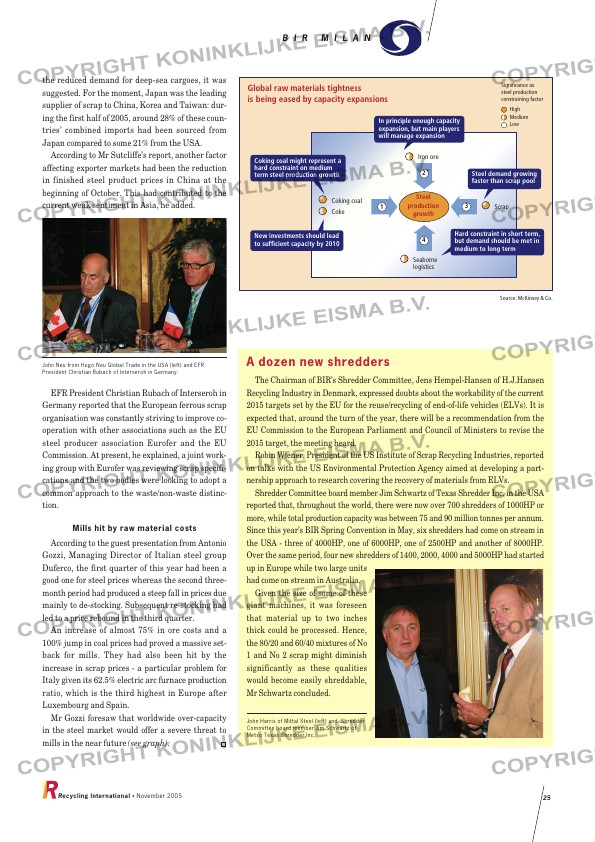Page 25 from: November 2005

the reduced demand for deep-sea cargoes, it was
suggested. For the moment, Japan was the leading
supplier of scrap to China, Korea and Taiwan: dur-
ing the first half of 2005, around 28% of these coun-
tries’ combined imports had been sourced from
Japan compared to some 21% from the USA.
According to Mr Sutcliffe’s report, another factor
affecting exporter markets had been the reduction
in finished steel product prices in China at the
beginning of October. This had contributed to the
current weak sentiment in Asia, he added.
EFR President Christian Rubach of Interseroh in
Germany reported that the European ferrous scrap
organisation was constantly striving to improve co-
operation with other associations such as the EU
steel producer association Eurofer and the EU
Commission. At present, he explained, a joint work-
ing group with Eurofer was reviewing scrap specifi-
cations and the two bodies were looking to adopt a
common approach to the waste/non-waste distinc-
tion.
Mills hit by raw material costs
According to the guest presentation from Antonio
Gozzi, Managing Director of Italian steel group
Duferco, the first quarter of this year had been a
good one for steel prices whereas the second three-
month period had produced a steep fall in prices due
mainly to de-stocking. Subsequent re-stocking had
led to a price rebound in the third quarter.
An increase of almost 75% in ore costs and a
100% jump in coal prices had proved a massive set-
back for mills. They had also been hit by the
increase in scrap prices – a particular problem for
Italy given its 62.5% electric arc furnace production
ratio, which is the third highest in Europe after
Luxembourg and Spain.
Mr Gozzi foresaw that worldwide over-capacity
in the steel market would offer a severe threat to
mills in the near future (see graph).
B I R M I L A N
Recycling International • November 2005 25
A dozen new shredders
The Chairman of BIR’s Shredder Committee, Jens Hempel-Hansen of H.J.Hansen
Recycling Industry in Denmark, expressed doubts about the workability of the current
2015 targets set by the EU for the reuse/recycling of end-of-life vehicles (ELVs). It is
expected that, around the turn of the year, there will be a recommendation from the
EU Commission to the European Parliament and Council of Ministers to revise the
2015 target, the meeting heard.
Robin Wiener, President of the US Institute of Scrap Recycling Industries, reported
on talks with the US Environmental Protection Agency aimed at developing a part-
nership approach to research covering the recovery of materials from ELVs.
Shredder Committee board member Jim Schwartz of Texas Shredder Inc. in the USA
reported that, throughout the world, there were now over 700 shredders of 1000HP or
more, while total production capacity was between 75 and 90 million tonnes per annum.
Since this year’s BIR Spring Convention in May, six shredders had come on stream in
the USA – three of 4000HP, one of 6000HP, one of 2500HP and another of 8000HP.
Over the same period, four new shredders of 1400, 2000, 4000 and 5000HP had started
up in Europe while two large units
had come on stream in Australia.
Given the size of some of these
giant machines, it was foreseen
that material up to two inches
thick could be processed. Hence,
the 80/20 and 60/40 mixtures of No
1 and No 2 scrap might diminish
significantly as these qualities
would become easily shreddable,
Mr Schwartz concluded.
John Harris of Mittal Steel (left) and Shredder
Committee board member Jim Schwartz of
Metso Texas Shredder Inc.
Global raw materials tightness
is being eased by capacity expansions
Coking coal
Coke
Significance as
steel production
constraining factor
High
Medium
Low
Iron ore
Seaborne
logistics
Scrap
Steel
production
growth
1
2
4
3
In principle enough capacity
expansion, but main players
will manage expansion
Steel demand growing
faster than scrap pool
Hard constraint in short term,
but demand should be met in
medium to long term
Coking coal might represent a
hard constraint on medium
term steel production growth
New investments should lead
to sufficient capacity by 2010
John Neu from Hugo Neu Global Trade in the USA (left) and EFR
President Christian Rubach of Interseroh in Germany.
Source: McKinsey & Co.
RI_017 BIR ferrous 04-11-2005 09:42 Pagina 25



